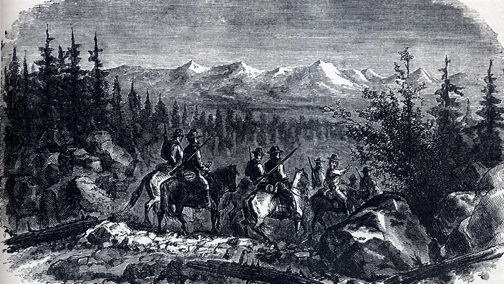Introduction & Purpose
"Volunteers On The March" (Glisan 1874: 293).
Coquelle Trails: Early Historical Roads and Trails of Ancestral Coquille Indian Lands, 1826 - 1875 renews a project originally started in 2006 to investigate and publish a “cultural geography” of the modern Coquille Indian Tribe: a description of the physical landscape and geographic area occupied or utilized by the Ancestors of the modern Coquille Tribe prior to -- and at the time of -- the earliest reported contacts with Europeans and Euro-Americans. Coquelle Trails is the first of what is expected to be several installments that will complete this renewed Cultural Geography Project.
Although ships and sailors made contact with Indians in earlier years, the focus of this report begins with the first historical land-based contacts between Indians and foreigners along the rivers and beaches of Oregon’s south coast. Those few and brief encounters are documented in poorly written and often incomplete journals of men who, without maps or a true fix on their locations, wandered into and across the lands of Hanis, Miluk, and Athapaskan speaking Indians in what is today Coos and Curry Counties. Those wanderings were the first surges of the tidal wave of America’s Manifest Destiny that would soon wash over the Indians and their country.
The absence of a written language, combined with the near total destruction of their populations and material culture almost immediately after these early encounters, leaves the Indian “voice” nearly absent from this report. However, the Indian “footprint” is not: the travels and travails of those first foreigners happened along the trails and routes of Indians who had created and used them for millennia.
The maps, survey notes and tables found herein are intended as a template and framework for future Cultural Geography investigations and reports: some of them for public consumption; others for the internal or proprietary uses of the Tribe. Knowing how and where people traveled -- knowing something about the canoe landings, the beach corridors, and the upland routes, campgrounds and campsites -- helps toward more complete understandings and interpretations of the Ancestors; and things about their lives in ways helpful to their descendants today.
The geography explored in this report is not exclusive to the modern Coquille Tribe: there are two other federally recognized tribes whose ancestors also called these lands home. Thus, this report does not seek to prove or provide evidence for any current or anticipated legal/political argument or debate about the exclusive rights or domains of any group of Indians or tribes, past or present. Nor does it attempt to suggest any cultural attribute -- except perhaps “village” or “townsite” -- that can be construed as uniquely that of any group mentioned or alluded to in this report.
Finally: the authors of this report hope its contents will inspire interest and funding for further investigations about the ancestral landscape discussed. There is still much to learn and report about the ecologies and environment that once were: also victims of the dramatic and sometimes disastrous changes brought on by the waves of immigrant foreigners -- and by the abrupt removal of the original Indian inhabitants from their homelands and landscapes.
